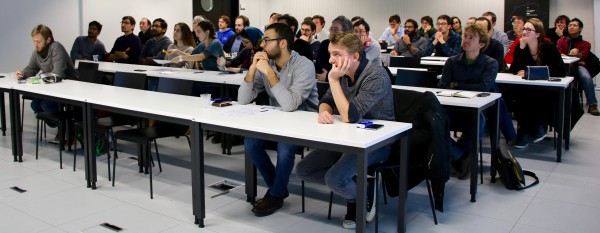MARVEL Junior Seminar — April 2021
Zoom meeting link:
https://epfl.zoom.us/j/93881551248
Password: 3417
The MARVEL Junior Seminars aim to intensify interactions between the MARVEL Junior scientists belonging to different research groups.
Each seminar consists of two presentations of 25 minutes each, allowing to present on a scientific question in depth, followed by time for discussion. The discussion is facilitated and timed by the chair.

MARVEL Junior Seminar Organizing Committee — Michele Kotiuga, Sara Fiore, Stefano Falletta, Kristians Cernevics and Patrick Mayor
Talk 1 — A microscopic picture of paraelectric perovskites
Michele Kotiuga1, Boris Kozinsky2, Marco Fornari3, Nicola Marzari1, Giovanni Pizzi1
1 Laboratory of Theory and Simulation of Materials (THEOS), EPFL
2 John A. Paulson School of Engineering and Applied Sciences, Harvard University & Robert Bosch LLC, Research and Technology Center
3 Dept. of Physics and Science of Advanced Materials Program, Central Michigan University
Paraelectric phases possess local polar displacements which fluctuate resulting in a disordered state with no net polarization. A microscopic picture of such a disordered state is challenging to quantify. Here, we first show with ab initio molecular dynamics that local (111) ferroelectric displacements can be sustained well above the Curie temperature in barium titanate (BaTiO3). Second, we employ a systematic symmetry analysis to identify paraelectric prototypes: the smallest cells that display both local ferroelectric patterns and the symmetry of the paraelectric phase. Two of these prototypes are more stable than a primitive BaTiO3 cubic cell and, remarkably, do not display any unstable phonon modes. We explore the stability of these prototypes across the titanates, as well as a broader set of oxide perovskites, as a function of volume and in relation to the unstable phonon modes of the primitive cell, both providing a microscopic structural model to study the different phases, and identifying the conditions under which a disordered paraelectric phase persists.
Talk 2 — Machine-learning the transition density of the productive excited states of azo-dyes
Sergi Vela, Alberto Fabrizio, Ksenia R. Briling and Clémence Corminboeuf
Computational Materials Design Laboratory (LCMD), EPFL
The ab initio determination of the character and properties of electronic excited states (ES) is the cornerstone of modern theoretical photo-chemistry. Nonetheless, traditional ES methods become readily impractical when applied to extremely large molecules, or when used on thousands of different chemical systems. In contrast, Machine Learning (ML) techniques have demonstrated their accuracy at retrieving ES properties of large molecular databases at a reduced computational cost. However, current methods exploit one dedicated ML model for each property. The more efficient alternative of learning fundamental objects, from which several ES properties can be extracted through post-processing, has remained elusive. In this talk, I will present the general framework able to learn two fundamental objects of an ES: the hole and particle densities. I will show the advantages of targeting those primary outputs of an ES computation, despite the additional complexity of learning 3-dimensional scalar fields, and I will show the application of our predictions to obtain a large set of derived properties, including the analysis of the state character and the topological descriptors of the exciton, for the two bands (nπ* and ππ*) of a collection of 3432 azoheteroarene photoswitches.
Check the list of the next MARVEL Junior Seminars here.
Low-volume newsletters, targeted to the scientific and industrial communities.
Subscribe to our newsletter